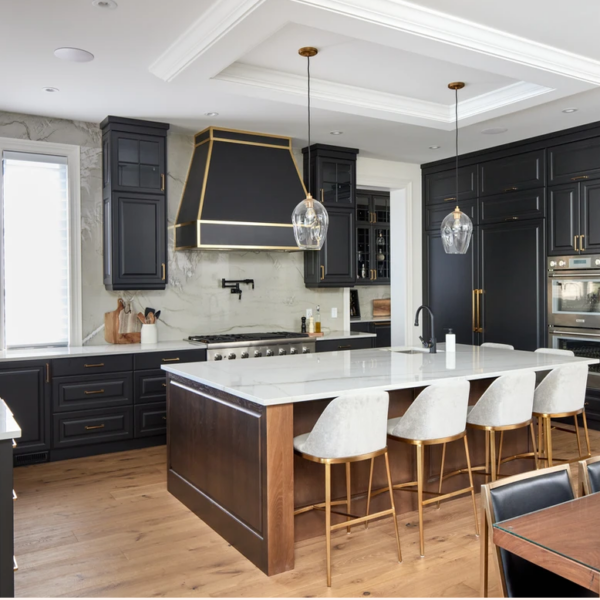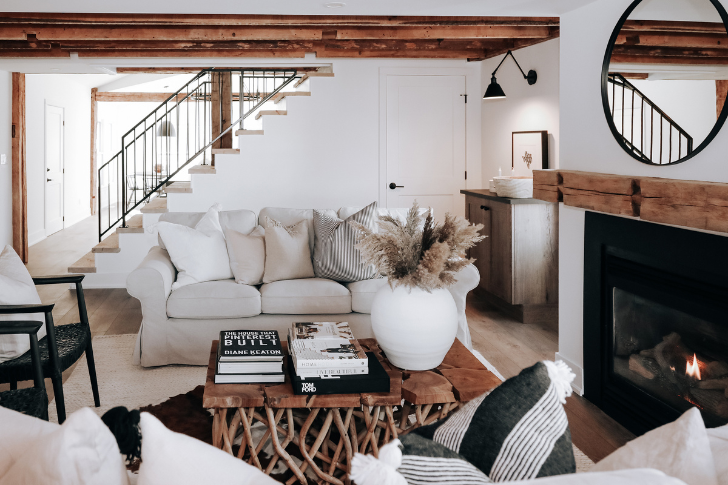
In a renovation like no other, RenoMark member Valleyburn Properties revitalized and rebuilt a 182-year-old, pioneer-built heritage home nestled in a historic village in Sparta, Ontario. The transformation involved unravelling more than 150 years’ worth of previous renovations to reveal and honour the original pioneer-built craftsmanship, while modernizing the home. The final product emphasizes beautiful hand-hewn beams, intricately chiseled mortise-and-tenon joints and evidence of hard work from a time long before electric tools.
The impressive project, dubbed “The Timberframe Revival,” won the Best Single Room Renovation and the Best Home Renovation – $200,000 – $400,000 in the 2022 CHBA National Awards for Housing Excellence, and resulted in Valleyburn Properties winning the competition’s prestigious Renovation Excellence Award.
We sat down with Grant McDonald, President of Valleyburn Properties, based in St. Thomas, to get the details behind this award-winning renovation.
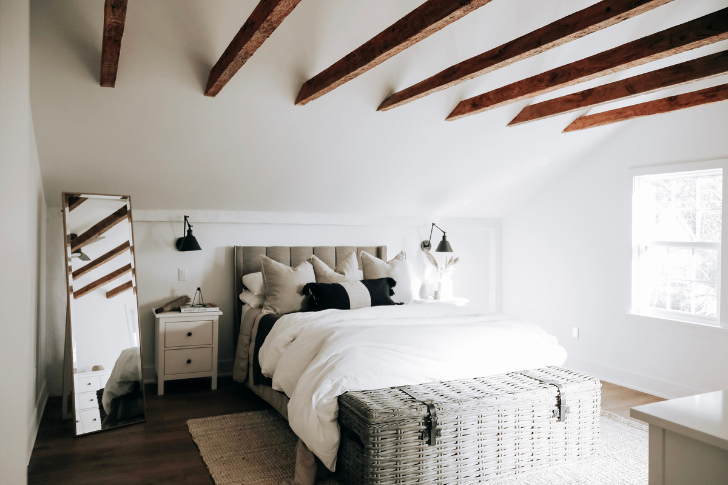
Bedroom renovation in the Timberframe Revival heritage home.
What does your company specialize in?
Valleyburn Properties is still a relatively new business that I like to call “boutique.” We do on average one or two full home rebuilds a year. I’ve always been of the mindset of quality versus quantity, and we are very selective about which projects we do – there’s a lot of passion, work, and thought put into each project.
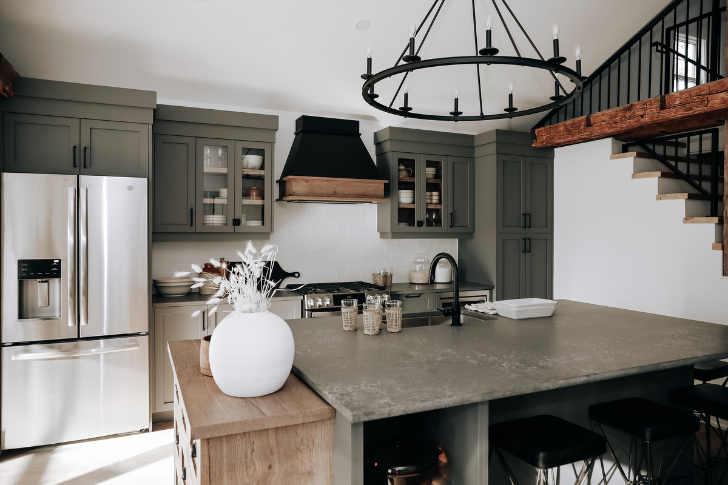
Kitchen dining space located in the back of the home with modern windows and beautiful hand-hewn beams.
Can you describe the Timberframe Revival Project in 30 seconds or less?
It’s exactly what the name describes! It’s a timber frame, with classic old architecture, that we revived.
The pioneers built this home 180 years ago using the old ancient art of timber framing. Since then, there’s been over a century’s worth of renovations that were kind of slapped on, layer over layer, on top of this home. We had to peel back each layer to learn about the property and really emphasize and expose all the original work, which was probably the most rewarding part of it all.
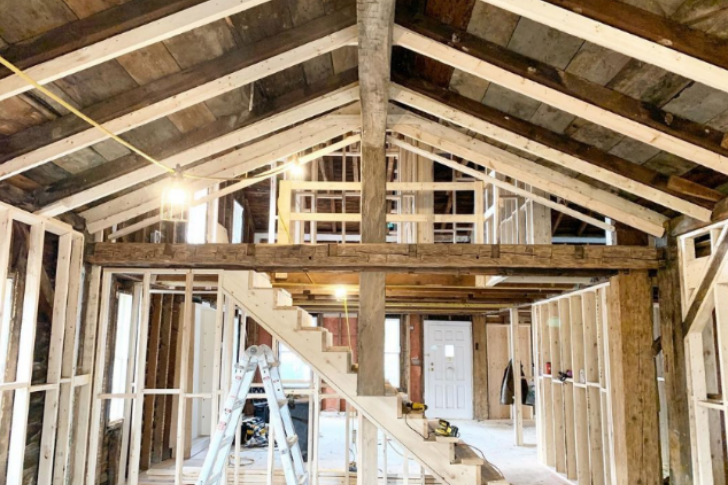
Photo of the Timberframe Revival mid-renovation. All exposed woodwork was meticulously cleaned and/or sanded to remove a century of debris, dust, and soot. Courtesy of Valleyburn Properties Instagram account.
Were there any surprises or challenges when you began looking behind the walls of this 180-year-old home?
There was a surprise behind every wall in this house!
It had been through different owners, different families, different eras, different renovations, different building products and building codes. If those walls could talk, right? It was fascinating to see all the layers, every single groove, nook and cranny, and mortise tenon, especially as we got to the very end. Looking at the bones of the structure, we could examine the way they used to build homes. They didn’t have power tools or electricity, it was horse and buggies and sheer strength – all hand chiselled and hand crafted.
It is fantastic that 180 years later the structure is so strong and square based on the construction techniques they used to use. This was the old original 1840 style of lath and plaster. Basically, what they would do is take a large plank of wood. Back then they had more trees and much more lumber, so it might have been a board an inch thick and 15 or 18 or 24 inches wide. They would actually take a hatchet and create a different bunch of curves. Then they’d be able to pull it out and stretch it out. They called it accordion lath and plaster. Really neat!

Living space where you can see the timber beams, repurposed wood on the mantel and Matte black accents (including custom-built wrought iron railings up the stairs) reminiscent of the blacksmith days.
This project found a great balance between modernizing the space and honouring the original craftmanship. What do you think is the key to finding that balance?
Unlike in new home construction where you know what to expect, projects like these have blueprints that are constantly changing. Nothing is set in stone and plans are never really finalized until you peel back the layers and see everything. For example, we’d originally planned for The Timberframe Revival’s kitchen to be more in the front of the home instead of in the back where it is now. But when we began carefully deconstructing the ceiling in the back of the home, I took a flashlight, looked up and realized – holy cow – it goes all the way up there! We then completely reconfigured the house to have the kitchen in the back with beautiful, grandiose vaulted ceilings.
.jpg)

Kitchen before the transformation (left) and kitchen after located in the back of the home with vaulted ceilings.
For this home, you worked closely with your local Historical Society, Municipal Mayor and family descendant of the original home. Why is that important for heritage homes?
Old homes are an important piece of history – locally, as well as from a building and craftsmanship perspective. It’s important to work with decision-makers to gain their insights, and I hope they have a little bit of pride of ownership too when they drive by the home.
There was a lot of history we were able to pull up on this home. For example, the mayor was able to pull up documentation on what the grid patterns on the windows used to be 180 years ago. Recreating original single pane windows wasn’t cost-effective or environmentally friendly, so we made new vinyl custom windows with the proper grids to maintain the look from the exterior.
Another unique component of this house is it has two front doors. Back in 1840, the original gentleman that built the home had a small tailor shop on the left side of the house. It was a cost-effective way to live on one side and have his small shop on the other, so it’s always had two doors. So, one request that was made was to keep the two doors to maintain that story of the home. We were also able to replicate and even salvage a lot of the original ornate trim work.
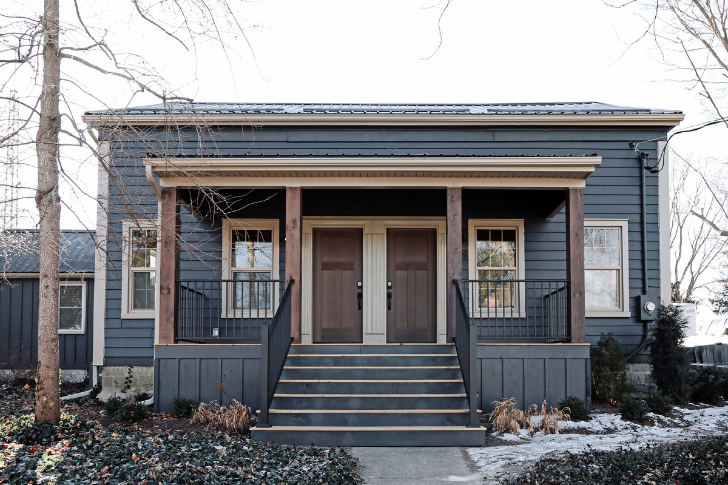
Front of the home featuring the two front doors that used to be the entrance into the homeowner’s living space on one side and tailor shop on the left.
What advice do you have for homeowners and renovators embarking on a renovation of an older home or heritage home?
No matter how much experience your contractor has, it’s next to impossible to truly pinpoint a budget with older homes. Renovation looks so easy on HGTV, but the reality is much more complicated (and often pricier). Make sure that you truly calculate your maximum budget and then reverse engineer that a little bit so you’ve got a nice cushion when unexpected things happen.
This year Valleyburn properties won Best Single Room Renovation, Best Home Renovation – $200k-$400k, and the Renovation Excellence Award in the 2022 CHBA National Awards for Housing Excellence. How does that feel?
You know, in all honesty it’s still very surreal. We’re a small company that’s fairly new to being in this business, so just to be listed as a finalist against a lot of incredible companies was a huge accomplishment in my eyes, let alone to be able to actually take home a few winning prizes. I don’t think it’s truly set in yet.
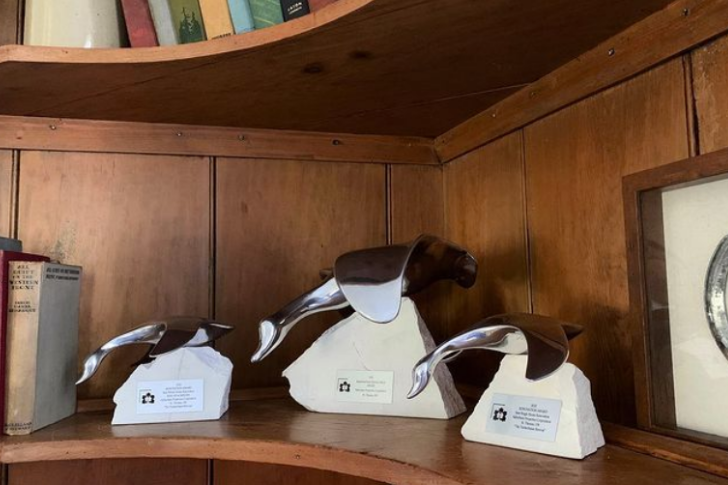 Valleyburn Properties Instagram account.
Valleyburn Properties Instagram account.
Looking back on this award-winning project, what do you feel most proud of? What did you learn that will keep with you in future projects?
I’m proud of this whole project and really want to emphasize the hard work of my subtrades. Everyone was able to work together on this challenging home, which was far from a typical new construction. It was a learning experience from start to finish.
We had beams that ran left, right and center, in all the cavities where you’d typically be able to run mechanicals. We had to get super creative. Each day there was something new to overcome and brainstorm. But we did it.
Now the home is very modernized, very comfortable and very environmentally friendly and energy efficient. But you still have the accentuated and exposed craftsmanship that you can walk through at notice unique notches and hand-hewn work that tells a story. A balance between this cozy old-time, pioneer feel that still feels like a home.
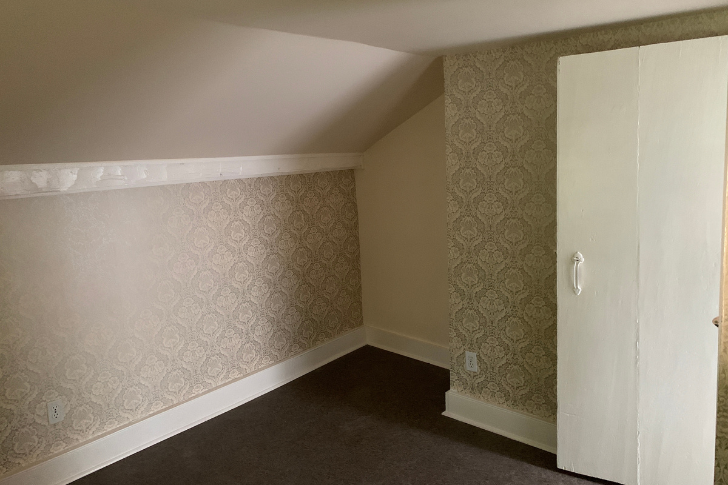
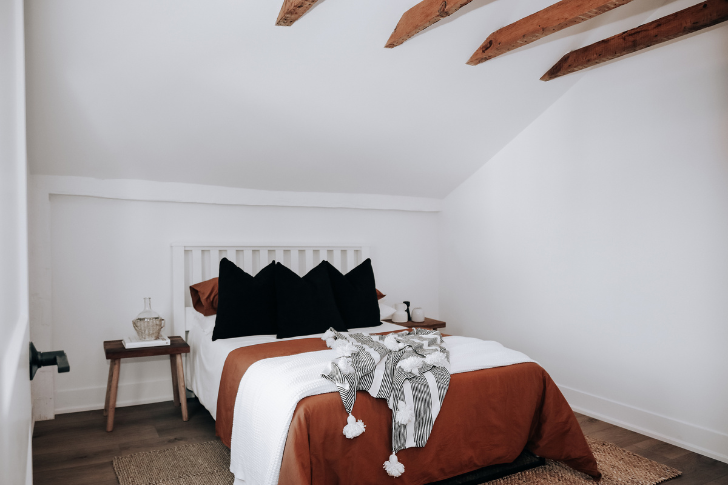
Guest room before (left) and after (right) where you can see the where the ceiling was extended to feature the beams.
Any projects you currently have on the go you can tell us about?
We’ve been working behind the scenes on a really exciting property. It’s an old farmhouse that was built back in 1872. It has cobblestone construction and all of the walls are about 20 inches of thick stone. But the entire exterior is made of small, hand-selected individual pebbles or cobblestones that were picked out of rivers. It took them about two years to collect all those stones 150 years ago. It’s a beautiful old home with tons of character.
It’s one of the only ones in Canada that are built like that. There’s a cluster of homes with the same construction down in New York State from the late 1800s. It was actually the nephew of one of those New York stone masons who built this home. So, the old gentleman, he was about 78 or 80 years old, made the trek to Sparta from NY state on his horse and buggy, likely with his necessities and tools. So we’re really excited to be able to bring that one back to life.
Learn more about Valleyburn Properties by visiting their website or Instagram account to see the progress of Grant’s future projects.
If you’re ready to start talking to a professional about renovating your own home, whether it was built in the 80’s or 1800’s, you can find a trusted contractor in your area through RenoMark’s professional directory.



